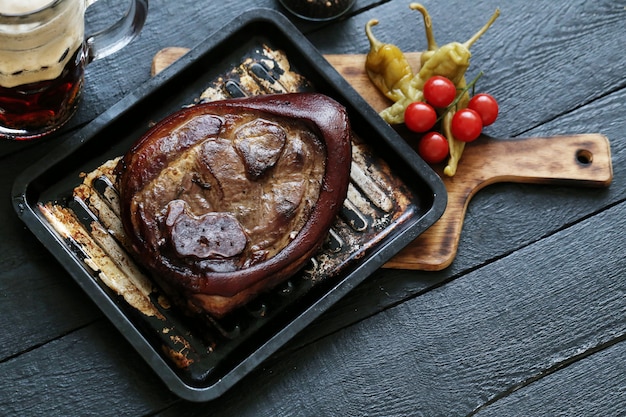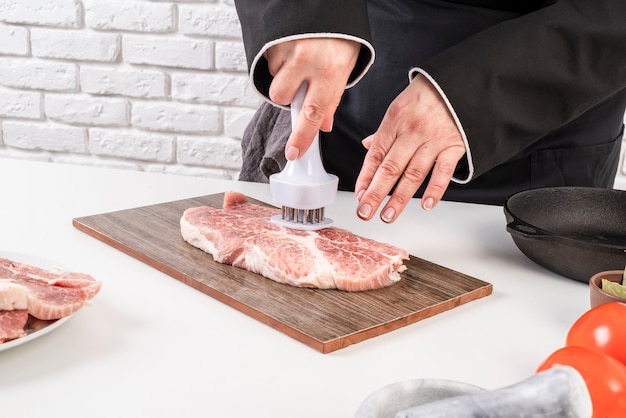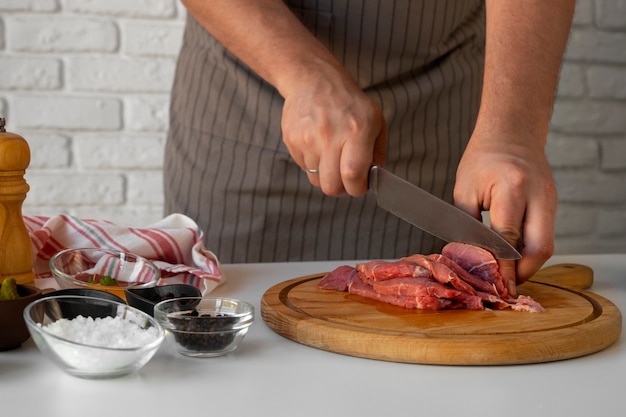Ah, steak. There's nothing quite like it, is there? That beautiful char on the outside, the juicy pink center, the satisfying sizzle on the grill – it's a culinary experience that's hard to beat. As a seasoned steak enthusiast, I've learned a thing or two about achieving that perfect bite, and I'm excited to share my secrets with you. Whether you're a seasoned grill master or a newbie in the kitchen, this guide will walk you through every step, from picking the right cut to mastering the art of searing and resting, ensuring you create a steak that melts in your mouth.
Part 1: Choosing the Perfect Cut

Let's start at the beginning, with the most crucial decision: the cut of sirloin. You see, not all sirloins are created equal, and selecting the right one can make a world of difference in the final product. My personal favourite? A thick-cut sirloin. It's got that beautiful marbling, which adds so much flavour and keeps the steak wonderfully juicy, and it holds up beautifully when cooked to a perfect medium-rare. Now, let's dive into the different cuts and their characteristics.
The Different Cuts of Sirloin: A Guide
Think of the sirloin as a family, with each member having its own personality. Let's meet them:
- Top Sirloin: This is the classic, the one you'll likely encounter most often. It's sometimes called a "top sirloin cap" or "top sirloin butt" (I know, fancy names!). It's leaner than its cousins, perfect for those who prefer a less fatty steak. You'll find it in varying thicknesses, but I always recommend going for a cut at least 1.5 inches thick for optimal results.
- bottom sirloin: Now, this one is the "bottom" part of the sirloin, and it tends to be a bit tougher than its top counterpart. It's often used for ground beef or roasts, but if you find a good thick-cut bottom sirloin, don't be afraid to give it a go! It can be grilled to a delicious medium-rare, but it might need a bit more tender love.
- Tri-Tip: This triangular cut is taken from the bottom sirloin and is known for its excellent flavour. It's a popular choice for grilling because it has a good amount of marbling and cooks very evenly. It's a bit of a hidden gem, so keep an eye out for it!
- Sirloin Tip: The sirloin tip is the tail end of the sirloin, and it tends to be tougher than the other cuts. It's often used for ground beef or stews, but if you find a good piece, it can be grilled to a decent medium-rare with some careful attention.
Marbling: The Secret to a juicy steak
When you're picking your sirloin, look for the marbling, which is the amount of intramuscular fat that runs throughout the meat. It's like the secret ingredient for flavour and tenderness. The more marbling, the more juicy and flavourful the steak will be. Aim for cuts with "good marbling", which means there's a good amount of fat running through the meat. You'll know it when you see it – it's like a beautiful network of white streaks throughout the red meat.
Part 2: Preparing the Steak

Now that you've got your perfect sirloin, it's time to prep it for grilling. This stage sets the foundation for a truly delicious and juicy steak, so pay attention!
Bringing it to Room Temperature: A Crucial Step
First things first, take your steak out of the fridge and let it sit at room temperature for about 30 minutes before grilling. This might seem like a minor detail, but it's absolutely crucial for achieving even cooking. When you cook a cold steak, the outside can get overcooked before the inside reaches the desired temperature. You want to avoid that "burnt outside, raw inside" situation, right? So, be patient, and let the steak come to room temperature.
Seasoning: The Art of Enhancing Flavour
Next, season your steak generously with salt and pepper. I always use freshly ground black pepper for that extra bit of oomph! Don't be shy with the salt – it's not about making the steak salty, but about enhancing the natural flavours of the meat. Think of it as unlocking the steak's full potential. If you want to get fancy, you can experiment with other seasonings like garlic powder, onion powder, paprika, or even a pinch of smoked paprika for a smoky flavour. But keep it simple; the steak should be the star of the show.
Don't Trim the Fat: It's Your Friend!
Most sirloins come with a layer of fat on the outside. Don't trim it off! This fat is your secret weapon for flavour and tenderness. As it cooks, it renders down, adding richness and moisture to the steak. Just make sure to remove any large chunks of fat or connective tissue, as they can burn and give an unpleasant flavour. Trust me, the fat is your friend!
Part 3: Mastering the Grill

This is where the magic happens – the grilling process itself. And remember, a hot grill is your best friend for a perfect sirloin. Let's get those flames blazing!
Heat It Up: The Hotter the Better
First things first, get your grill nice and hot. Aim for medium-high heat, around 450-500°F (232-260°C). If you're using a gas grill, let the burners heat up for 10-15 minutes before placing the steak on the grill. You'll know it's ready when you hold your hand about 5 inches above the grill and feel the heat radiating back. If it's too hot to hold your hand there for more than 2 seconds, you're ready to go.
Sealing in the Juices: The Art of Searing
Once the grill is hot, place the steak directly over the heat. This is the most crucial part of the grilling process. This step creates that beautiful sear on the outside, which seals in all the delicious juices. Let the steak cook for 2-3 minutes on each side, undisturbed. Don't move it around too much, or you risk sticking and ruining the sear. Just let it sit and sizzle. You'll hear the sound of the steak releasing from the grill, indicating it's ready to be flipped.
The Flip: Moving to a Cooler Zone
After searing both sides, move the steak to a cooler part of the grill or turn the heat down a bit. This helps ensure the steak cooks evenly without burning the outside. Keep the lid closed, allowing the steak to cook through gently.
Timing is Everything: The Doneness Levels
Now, the cooking time depends on how you like your steak done. Here's a general guideline for cooking times, keeping in mind that these are just approximations, and the specific time will depend on your steak's thickness and your grill's heat:
Rare: 2-3 minutes per side
Medium-Rare: 3-4 minutes per side
Medium: 4-5 minutes per side
Medium-Well: 5-6 minutes per side
Well-Done: 6-7 minutes per side
Remember, these are just guidelines. Use a meat thermometer to ensure your steak is cooked to your liking. Insert the thermometer into the thickest part of the steak to get an accurate reading.
The Rest: Letting the Juices Redistribute
Once the steak is cooked to your desired temperature, take it off the grill and let it rest for 5-10 minutes before slicing and serving. This is a critical step that often gets overlooked, but it's crucial for allowing the juices to redistribute throughout the steak, resulting in a more tender and flavorful cut. It might be tempting to dive in right away, but trust me, the patience is worth it! The steak will continue to cook slightly as it rests, ensuring that it's perfectly cooked throughout.
Part 4: Beyond the Basics
Now, we've covered the fundamentals of grilling a perfect sirloin, but there are a few extra tips and tricks to take your steak game to the next level. These techniques are all about adding variety and sophistication to your grilling skills.
Cross-Hatch Grilling: The Art of the Beautiful Sear
For a beautiful grill mark and even cooking, try cross-hatch grilling. This involves grilling the steak for 2-3 minutes on each side, then rotating it by 90 degrees and repeating the process. This results in that lovely criss-cross pattern that looks as good as it tastes. It's a simple technique, but it makes a big difference in the presentation and flavour of your steak.
reverse sear: Slow and Steady Wins the Race
For a more tender and juicy steak, consider reverse searing. This is a bit more time-consuming, but it's worth it for the results. It involves cooking the steak slowly at a low temperature (around 250°F/121°C) until it reaches an internal temperature of about 110°F/43°C. Then, sear the steak over high heat for a minute or two on each side to create a beautiful crust. The slow cooking allows the steak to cook evenly throughout, resulting in a tender and flavorful steak. The final sear adds that crispy, delicious crust that we all love.
Sous Vide: Precision Cooking for the Perfectionist
If you're looking for the ultimate precision and control, try sous vide cooking. This is the ultimate way to achieve perfectly cooked steak, time and time again. It involves sealing the steak in a vacuum bag and submerging it in a water bath set to your desired internal temperature. Sous vide ensures even cooking throughout, resulting in a perfectly cooked steak every time. You can then sear the steak to achieve a beautiful crust. It's a bit more of an investment, as you'll need a sous vide machine, but it's a great option for those who want to take their steak game to the next level.
Part 5: Serving Your Masterpiece
The anticipation is building, and your perfectly grilled sirloin is ready to be devoured. Now, let's talk about the perfect finishing touches to make your culinary creation truly shine.
Sides: The Perfect Accompaniments
A delicious steak deserves equally delicious accompaniments. Here are a few ideas for sides that complement the richness and flavour of your sirloin:
- Roasted Vegetables: roasted asparagus, Brussels sprouts, or carrots are classic sides for steak. The roasting process brings out their natural sweetness and creates a beautiful caramelization that pairs perfectly with the steak's savory flavours.
- grilled corn on the Cob: The smoky flavour of grilled corn is a match made in heaven with steak. It adds a touch of sweetness and a bit of textural contrast.
- potato salad: A creamy potato salad adds a refreshing contrast to the richness of the steak. It's a classic pairing that always works well.
- Mac and Cheese: A decadent mac and cheese is a comforting and satisfying accompaniment. It's a bit more indulgent, but it's perfect for a special occasion.
- mashed potatoes: A classic side for steak, mashed potatoes can be made with a variety of herbs and spices. They add a creamy texture and a comforting flavour that complements the steak.
Sauces: Elevating the Flavour Profile
A good steak sauce can elevate the flavour profile of your sirloin, adding a touch of complexity and richness. Here are a few options to consider, each with its own unique character:
- Béarnaise Sauce: A classic French sauce made with egg yolks, butter, and herbs. It's rich, creamy, and tangy, adding a sophisticated touch to your steak.
- Red Wine Sauce: A simple yet flavorful sauce made with red wine, shallots, and herbs. It's perfect for pairing with a grilled sirloin, enhancing the meat's natural flavours.
- Mushroom Sauce: A creamy sauce made with sautéed mushrooms, shallots, and cream. It's a delicious and earthy accompaniment to steak, adding a umami depth that complements the meat.
- Peppercorn Sauce: A spicy and flavorful sauce made with black peppercorns, brandy, and cream. It's a great way to add a bit of heat and complexity to your steak.
Part 6: Steak Done Right
Here's a handy table summarising the different doneness levels for steak and their corresponding internal temperatures. This is a great reference to ensure that you achieve your desired level of doneness every time.
| Doneness Level | Internal Temperature (°F) | Internal Temperature (°C) |
|---|---|---|
| Rare | 125-130 | 52-54 |
| Medium-Rare | 130-135 | 54-57 |
| Medium | 135-140 | 57-60 |
| Medium-Well | 140-145 | 60-63 |
| Well-Done | 145-150 | 63-65 |
Remember, these are just guidelines. You can adjust the internal temperature to your personal preference. If you're unsure, always err on the side of caution and cook the steak a bit less. It's always easier to cook a steak a bit more than to try to "uncook" it! Trust your instincts, and your taste buds will thank you.
Part 7: FAQs
Let's address some commonly asked questions about grilling the perfect sirloin steak. These are the questions that often pop up in the minds of both seasoned grillers and newbies.
1. What if my steak sticks to the grill?
If your steak is sticking to the grill, it's likely that the grill isn't hot enough or that the steak hasn't been seasoned properly. Try preheating the grill to high heat and make sure to season the steak generously with salt and pepper. If you're still having trouble, you can try using a grill brush to clean the grill grates or spraying them with a non-stick cooking spray. The key is to create a hot, clean surface for the steak to cook on.
2. How can I tell if my steak is cooked to my desired doneness?
The best way to determine the doneness of your steak is to use a meat thermometer. Insert the thermometer into the thickest part of the steak to get an accurate reading. This is the most reliable method, as it eliminates any guesswork. You can also use the "finger test," but this is less accurate. It involves pressing on the steak and comparing the feel to the firmness of your finger. Rare is soft, medium-rare is a bit firmer, medium is firmer, medium-well is very firm, and well-done is very hard. It's a good way to get an approximate idea, but it's not as accurate as using a thermometer.
3. What happens if I overcook my steak?
Overcooking a steak will make it tough and dry. If you've overcooked your steak, there's not much you can do to salvage it. However, you can try to slice it thinly and serve it with a sauce to help make it more palatable. The sauce will add moisture and flavour, helping to mask the dryness. Next time, be sure to keep a close eye on the steak and use a thermometer to ensure that it's cooked to your liking.
4. How do I store leftover steak?
Leftover steak can be stored in the refrigerator for up to 3-4 days. Wrap it tightly in plastic wrap or aluminum foil to prevent it from drying out. You can also store it in an airtight container. When you're ready to eat it, you can reheat it in the oven, microwave, or on the stovetop. It's best to reheat it slowly to avoid drying it out further.
5. Can I freeze steak?
Yes, you can freeze steak. Wrap it tightly in plastic wrap or aluminum foil and place it in a freezer-safe bag. Steak can be frozen for up to 3-4 months. To thaw the steak, place it in the refrigerator overnight or defrost it in the microwave. Freezing can affect the texture of the steak slightly, so it's best to freeze it for short periods if possible. However, it's a great way to preserve steak for future use.
Part 8: The Final Word
There you have it – a comprehensive guide to grilling the perfect sirloin steak. Remember, the key to success is choosing the right cut, preparing it properly, and cooking it to your desired doneness. Don't be afraid to experiment with different techniques and seasonings to find what you like best. And most importantly, enjoy the process, savor the aromas, and relish the deliciousness of a perfectly cooked sirloin steak! It's a culinary experience that will leave you feeling satisfied and wanting more.
Everyone is watching

Prime Rib Roast Cooking Time Chart: Per Pound Guide
Cooking TipsPrime rib roast. Just the name conjures images of lavish dinners, crackling fires, and hearty laughter. It’s ...

How Long to Bake Potatoes in the Oven (Perfect Every Time)
Cooking TipsBaked potatoes are a staple in my kitchen. They're incredibly versatile, delicious, and surprisingly easy to m...

Perfect Rice Every Time: The Ultimate Guide to Cooking Rice
Cooking TipsAs a self-proclaimed foodie, I've always been a bit obsessed with rice. It's the foundation of countless cuisi...

The Ultimate Guide to Cooking Asparagus: Tips, Techniques, and Recipes
Cooking TipsAsparagus. The mere mention of this spring delicacy conjures up images of vibrant green spears, crisp and burs...

Ultimate Guide to Cooking the Perfect Thanksgiving Turkey
Cooking TipsThanksgiving. Just the word conjures up images of overflowing tables laden with delicious food, the scent of r...
